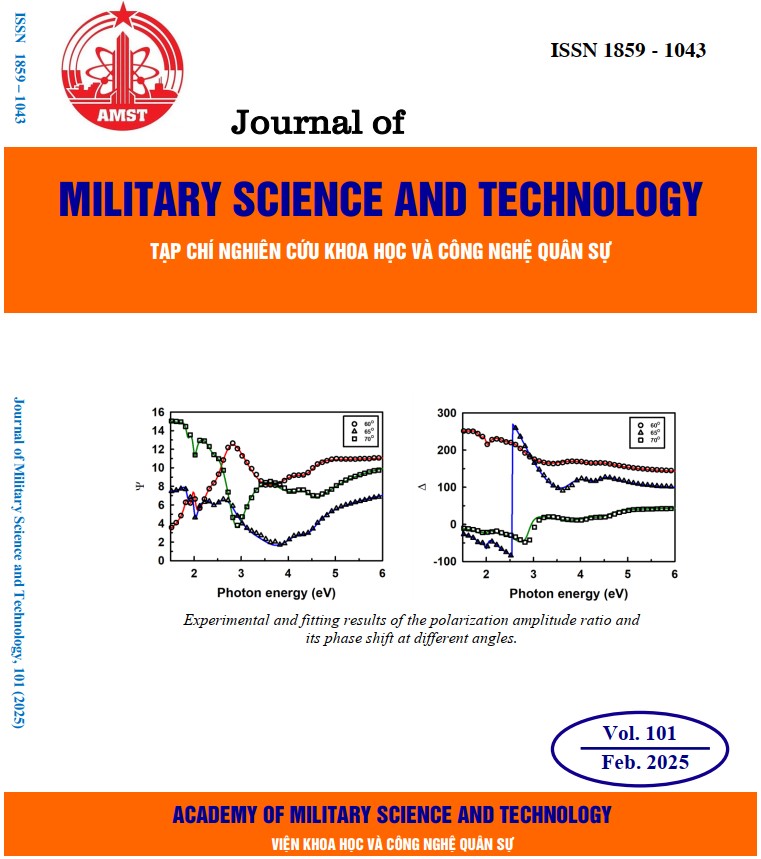Geometries and thermodynamic stability of [Mo3Se132-]@TM (TM = Sc-Ni) clusters: A theoretical investigation
410 viewsDOI:
https://doi.org/10.54939/1859-1043.j.mst.101.2025.110-116Keywords:
Atomic cluster; Mo3Se132-@TM; Thermodynamic stability; Dissociation energy; Entropy gradient.Abstract
We study the geometric structure and thermodynamic stability of Mo3Se132-@TM atomic clusters (TM = Sc, Ti, V, Cr, Mn, Fe, Co and Ni) using the B3LYP/LanL2DZ level within the density functional theory. The presence of transition metal in the Mo3Se132- clusters enhances the mobility of (Se-Se) terminals. Transition metal atoms preferentially attach to the sites, which forms the maximum number of bonds with Se atoms. Dissociation energy and entropy gradient analysis points out the Mo3Se132-@TM clusters favor to dissociate along two channels to create either Se-TM atoms or molecules. The [Mo3Se13]2-@Ti, [Mo3Se13]2-@Cr và [Mo3Se13]2-@Ni can be predicted to be clusters with great catalytic potential due to high stability and minimum energy of 1.91, 1.57 and 1.78 eV, respectively.
References
[1]. Lewis NS et al, “Powering the planet: chemical challenges in solar energy utilization” Proc Natl Acad Sci USA 103, 15729e35, (2006). DOI: https://doi.org/10.1073/pnas.0603395103
[2]. Walter MG et al, “Solar water splitting cells” Chem Rev 110, 6446e73, (2010). DOI: https://doi.org/10.1021/cr1002326
[3]. Roger I et al, “Earth-abundant catalysts for electrochemical and photoelectrochemical water split-ting” Nat Rev Chem 1, 0003, (2017). DOI: https://doi.org/10.1038/s41570-016-0003
[4]. McKone JR et al, “Earth-abundant hydrogen evolution electrocatalysts” Chem Sci 5, 865e78, (2014). DOI: https://doi.org/10.1039/C3SC51711J
[5]. Liu Y et al, “Self-optimizing, highly surfaceactive layered metal dichalcogenide catalysts for hy-drogen evolution” Nat Energy 2, 17127, (2017). DOI: https://doi.org/10.1038/nenergy.2017.127
[6]. Tran PD et al, “Coordination polymer structure and revisited hydrogen evolution catalytic mecha-nism for amorphous molybdenum sulfide” Nat Mater 15, 640e6, (2016). DOI: https://doi.org/10.1038/nmat4588
[7]. Merki D et al, “Amorphous molybdenum sulfide films as catalysts for electrochemical hydrogen production in water” Chem Sci 2, 1262e7, (2011). DOI: https://doi.org/10.1039/C1SC00117E
[8]. Benck JD et al, “Amorphous molybdenum sulfide catalysts for electrochemical hydrogen produc-tion: insights into the Origin of their catalytic activity” ACS Catal 2, 1916e23, (2012). DOI: https://doi.org/10.1021/cs300451q
[9]. Ding Q et al, “Efficient electrocatalytic and photoelectrochemical hydrogen generation using MoS2 and related compounds” Chem 1, 699e726, (2016). DOI: https://doi.org/10.1016/j.chempr.2016.10.007
[10]. Benck JD et al, “Catalyzing the hydrogen evolution reaction (HER) with molybdenum sulfide nano-materials” ACS Catal 4, 3957e71, (2014). DOI: https://doi.org/10.1021/cs500923c
[11]. Voiry D et al, “Low-dimensional catalysts for hydrogen evolution and CO2 reduction” Nat Rev Chem 2, 0105, (2018). DOI: https://doi.org/10.1038/s41570-017-0105
[12]. Nguyen QT et al, “Novel amorphous molybdenum selenide as an efficient catalyst for hydrogen evo-lution reaction” ACS Appl Mater Interfaces 10, 8659e65, (2018). DOI: https://doi.org/10.1021/acsami.7b18675
[13]. Chia X, Pumera M. “Inverse opal-like porous MoSex films for hydrogen evolution catalysis: overpo-tential-pore size dependence” ACS Appl Mater Interfaces 10, 4937e45, (2018). DOI: https://doi.org/10.1021/acsami.7b17800
[14]. Gao D et al, “Dual-native vacancy activated basal plane and conductivity of MoSe2 with high-efficiency hydrogen evolution reaction” Small 14, 1704150, (2018). DOI: https://doi.org/10.1002/smll.201704150
[15]. Jian C, Cai Q, Hong W, Li J, Liu W. “Edge-riched MoSe2/MoO2 hybrid electrocatalyst for efficient hydrogen evolution reaction” Small 14, 1703798, (2018). DOI: https://doi.org/10.1002/smll.201703798
[16]. Ren X, Ma Q, Ren P, Wang Y. “Synthesis of nitrogen-doped MoSe2 nanosheets with enhanced elec-trocatalytic activity for hydrogen evolution reaction” Int J Hydrogen Energy 43, 15275e80, (2018). DOI: https://doi.org/10.1016/j.ijhydene.2018.06.122
[17]. Ren X, Yao Y, Ren Y, Wang Y, Peng Y. “Facile sol-gel synthesis of C@MoSe2 core-shell composites as advanced hydrogen evolution reaction catalyst” Mater Lett 238, 286e9, (2019). DOI: https://doi.org/10.1016/j.matlet.2018.12.036
[18]. He HY, He Z, Shen Q. “Efficient hydrogen evolution catalytic activity of graphene/metallic MoS2 nanosheet heterostructures synthesized by a one-step hydrothermal process” Int J Hydrogen Energy 43, 21835e43, (2018). DOI: https://doi.org/10.1016/j.ijhydene.2018.10.023
[19]. Liu Y et al, “Exfoliated MoS2 with porous graphene nanosheets for enhanced electrochemical hy-drogen evolution” Int J Hydrogen Energy 43, 13946e52, (2018). DOI: https://doi.org/10.1016/j.ijhydene.2018.02.039
[20]. Xu L et al, “Boosting electrocatalytic activity of ultrathin MoSe2/C composites for hydrogen evolu-tion via a surfactant assisted hydrothermal method” Int J Hydrogen Energy 43, 15749e61, (2018). DOI: https://doi.org/10.1016/j.ijhydene.2018.07.041
[21]. Han X, Tong X, Liu X, Chen A, Wen X, Yang N, Guo XY. “Hydrogen evolution reaction on hybrid catalysts of vertical MoS2 nanosheets and hydrogenated graphene” ACS Catal 8, 1828e36, (2018). DOI: https://doi.org/10.1021/acscatal.7b03316
[22]. Saadi FH et al, “Operando synthesis of macroporous molybdenum diselenide films for electrocataly-sis of the hydrogen-evolution reaction” ACS Catal 4, 2866e73, (2014). DOI: https://doi.org/10.1021/cs500412u
[23]. Thu Thi Phung et al, “Unraveling Hydrogen Adsorption on Transition Metal-Doped [Mo3S13]2– Clusters: Insights from Density Functional Theory Calculations” ACS Omega 9, 20467, (2024). DOI: https://doi.org/10.1021/acsomega.4c01557
[24]. M. J. Frisch, et al., Gaussian 09, Revision B. 01. Gaussian, Inc., Wallingford., (2009).
[25]. Chuc T. Nguyen et al, “Structure and electrochemical property of amorphous molybdenum selenide H2-evolving catalysts prepared by a solvothermal synthesis” J. Hydrogen Energy 44, 13273, (2019). DOI: https://doi.org/10.1016/j.ijhydene.2019.03.186
[26]. J. Shee et al. J. Chem. Theory Comput. 15, 2346, (2019). DOI: https://doi.org/10.1021/acs.jctc.9b00083







